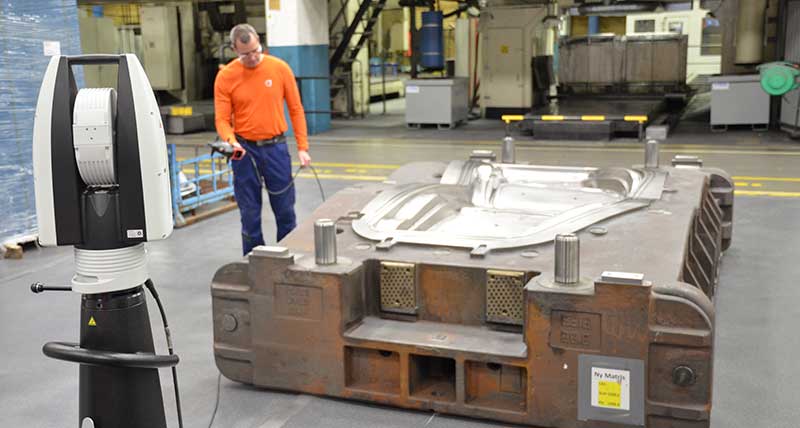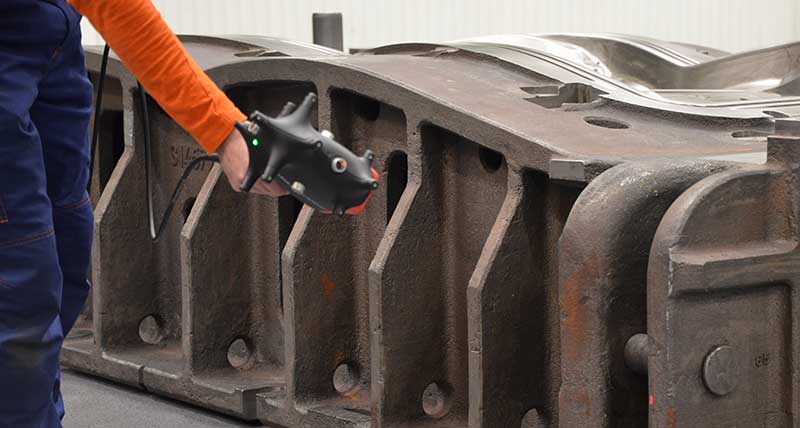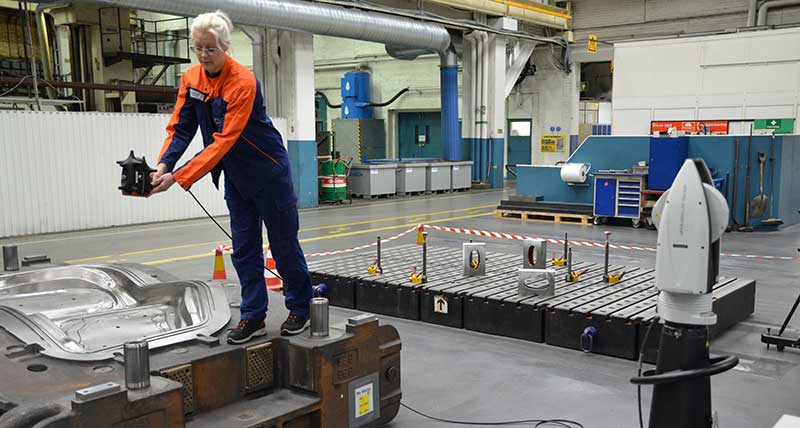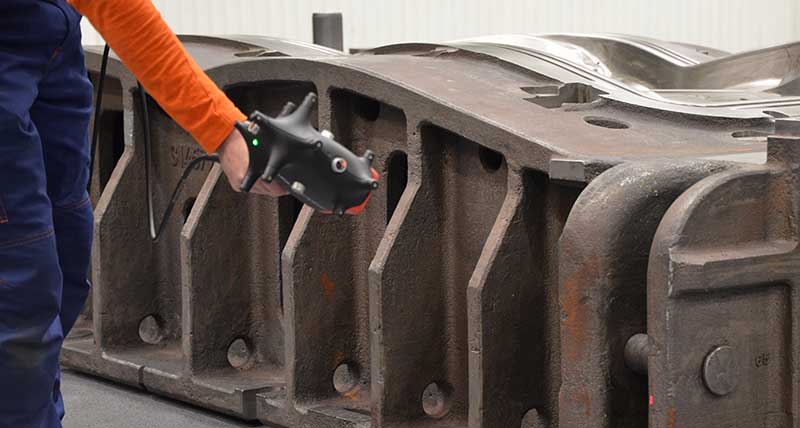Freedom to measure with Volvo
Productivity gains from prototyping through production with the AT960, LAS-XL and T-Scan 5
Contact us
With some 2400 employees, Volvo Car Body Components (VCBC) in Olofström is an automotive production plant that produces millions of car body parts every year. From hoods and roofs to doors and subassemblies, the facility is dedicated to pressing sheet metal into vital car components that are shipped whole or partially assembled to Volvo car factories around the world for final assembly and finishing.
The modern, high-tech and environmentally friendly factory in Olofström has a history going back almost 300 years – it was first established as an ironworks in 1735 and has delivered body parts for all Volvo cars since 1927. Since being purchased by Volvo in 1969, the last 50 years have seen the site dedicated to the pressing and partial assembly of car body parts for Volvo’s complete range of vehicles, as well as for external customers such as Volvo Trucks, Ford and Land Rover.
The earliest production stages of the car design process at Volvo rely heavily on the development of the sheet metal stamping tools designed and manufactured by the Tool and Die team at Olofström. The team is first responsible for producing tool prototypes, and with up with up to 80 tools needed for a vehicle project this can be four-to-five-month task. Each project typically runs for a year, and the remainder of the time is dedicated to producing the final tooling that will be used to press hundreds of thousands of car body components.
 In 2018, the team decided it was time to introduce a modern metrology solution to their tool prototyping and production with the goal of improving productivity. They identified several key steps in their design, production and validation process that could potentially benefit from the introduction of advanced measurement devices. Having a large and well-equipped quality room already in place, the team was familiar with a wide range of metrology hardware, from horizontal arm CMMs to structured light scanners. They were open to considering a number of the different systems currently available on the market, but one of their key considerations was identifying a solution that would be as at home on the shop floor as it was in the quality room.
In 2018, the team decided it was time to introduce a modern metrology solution to their tool prototyping and production with the goal of improving productivity. They identified several key steps in their design, production and validation process that could potentially benefit from the introduction of advanced measurement devices. Having a large and well-equipped quality room already in place, the team was familiar with a wide range of metrology hardware, from horizontal arm CMMs to structured light scanners. They were open to considering a number of the different systems currently available on the market, but one of their key considerations was identifying a solution that would be as at home on the shop floor as it was in the quality room.
With several Absolute Tracker systems already in use in the main part production areas of the Olofström plant, the site’s existing internal expertise combined with the well-known portability and flexibility of Absolute Tracker systems made choosing additional laser tracker systems from Hexagon a natural next step.
The first step in producing a designed prototype or final tool is the precision milling of a casted block of raw material. Casting is not a precise process, and the casted part is typically delivered with a lot of excess raw material which must be subsequently milled down to the correct size and shape with a CNC milling machine.
A key step in setting up a casted part for milling is ensuring that there is no collision between the milling machine and part as they are both moved into position before milling begins. Such a collision can result in very expensive and time-consuming damage to the CNC milling machine. Therefore, the operator must to introduce a safety factor when setting things up – positioning the machine far enough away from the material that they are sure no collision will occur. Doing this by eye is not easy, and often means that the milling machine spends a significant amount of time at the beginning of its program milling nothing.
“That initial scan data means you avoid wasting time here,” said Kim Tingstedt, Tool and Die Operator at VCBC Olofström. “When you optimise the milling program to the actual size of the material, that’s the big time saving, because it doesn’t matter if the machine goes through the air or through the material, it’s the same speed. Now we have a better lead time in the milling machines, and that means we can take more parts and tools.”
This optimisation was performed before, but with the comprehensive scan data provided by the LAS-XL, things are much easier. “When we are scanning, our constructors get more information, compared to the our previous CMM solution, which just gives points, so they can see a lot more things when we scan,” said Kim Tingstedt. “The constructor can take that data down to the CNC machine and they can much more easily optimise the milling part because they can really see the part.”
Now we have a better lead time in the milling machines. This casting scan data can be used in other ways to improve production. Tool castings are extremely heavy and difficult to move, so any possibility to make them lighter improves their usability and reduces the amount of raw materials required to make them. This means they have to be as small as possible – but they can’t be too small. If not enough material is left between the outside of the tool and the inside of its precision mould, it won’t be strong enough to withstand repeated high-power stamping.
Using scan data taken after casting, the casting of subsequent prototypes and final tools can be refined to ensure the minimum weight and raw material usage is achieved without diminishing the structural integrity of the tool. This also has the benefit of allowing the milling machine to begin its work closer to the final part shape with each iteration, compounding the time savings at every step.
The Leica Absolute Scanner LAS-XL is the perfect tool for this scanning process. It’s wide scan line and large standoff allow the casted part to be scanned very quickly, ensuring that the scanning is viable as a faster alternative to simply implementing a large safety factor when milling.
And with the LAS-XL’s market leading measurement standoff, it’s possible to measure hidden points within the cavities that are designed into the toolings in order to save on material usage and reduce final weight. A large-standoff scanner like the LAS-XL allows these cavities to be accurately measured so that the Tool and Die team can push the limits when it comes to saving materials and reducing weight without compromising the functionality of the tool.

The modern, high-tech and environmentally friendly factory in Olofström has a history going back almost 300 years – it was first established as an ironworks in 1735 and has delivered body parts for all Volvo cars since 1927. Since being purchased by Volvo in 1969, the last 50 years have seen the site dedicated to the pressing and partial assembly of car body parts for Volvo’s complete range of vehicles, as well as for external customers such as Volvo Trucks, Ford and Land Rover.
The earliest production stages of the car design process at Volvo rely heavily on the development of the sheet metal stamping tools designed and manufactured by the Tool and Die team at Olofström. The team is first responsible for producing tool prototypes, and with up with up to 80 tools needed for a vehicle project this can be four-to-five-month task. Each project typically runs for a year, and the remainder of the time is dedicated to producing the final tooling that will be used to press hundreds of thousands of car body components.
 In 2018, the team decided it was time to introduce a modern metrology solution to their tool prototyping and production with the goal of improving productivity. They identified several key steps in their design, production and validation process that could potentially benefit from the introduction of advanced measurement devices. Having a large and well-equipped quality room already in place, the team was familiar with a wide range of metrology hardware, from horizontal arm CMMs to structured light scanners. They were open to considering a number of the different systems currently available on the market, but one of their key considerations was identifying a solution that would be as at home on the shop floor as it was in the quality room.
In 2018, the team decided it was time to introduce a modern metrology solution to their tool prototyping and production with the goal of improving productivity. They identified several key steps in their design, production and validation process that could potentially benefit from the introduction of advanced measurement devices. Having a large and well-equipped quality room already in place, the team was familiar with a wide range of metrology hardware, from horizontal arm CMMs to structured light scanners. They were open to considering a number of the different systems currently available on the market, but one of their key considerations was identifying a solution that would be as at home on the shop floor as it was in the quality room.With several Absolute Tracker systems already in use in the main part production areas of the Olofström plant, the site’s existing internal expertise combined with the well-known portability and flexibility of Absolute Tracker systems made choosing additional laser tracker systems from Hexagon a natural next step.
Improving the initial casting
The first step in producing a designed prototype or final tool is the precision milling of a casted block of raw material. Casting is not a precise process, and the casted part is typically delivered with a lot of excess raw material which must be subsequently milled down to the correct size and shape with a CNC milling machine.A key step in setting up a casted part for milling is ensuring that there is no collision between the milling machine and part as they are both moved into position before milling begins. Such a collision can result in very expensive and time-consuming damage to the CNC milling machine. Therefore, the operator must to introduce a safety factor when setting things up – positioning the machine far enough away from the material that they are sure no collision will occur. Doing this by eye is not easy, and often means that the milling machine spends a significant amount of time at the beginning of its program milling nothing.
“That initial scan data means you avoid wasting time here,” said Kim Tingstedt, Tool and Die Operator at VCBC Olofström. “When you optimise the milling program to the actual size of the material, that’s the big time saving, because it doesn’t matter if the machine goes through the air or through the material, it’s the same speed. Now we have a better lead time in the milling machines, and that means we can take more parts and tools.”
This optimisation was performed before, but with the comprehensive scan data provided by the LAS-XL, things are much easier. “When we are scanning, our constructors get more information, compared to the our previous CMM solution, which just gives points, so they can see a lot more things when we scan,” said Kim Tingstedt. “The constructor can take that data down to the CNC machine and they can much more easily optimise the milling part because they can really see the part.”
Now we have a better lead time in the milling machines. This casting scan data can be used in other ways to improve production. Tool castings are extremely heavy and difficult to move, so any possibility to make them lighter improves their usability and reduces the amount of raw materials required to make them. This means they have to be as small as possible – but they can’t be too small. If not enough material is left between the outside of the tool and the inside of its precision mould, it won’t be strong enough to withstand repeated high-power stamping.
Using scan data taken after casting, the casting of subsequent prototypes and final tools can be refined to ensure the minimum weight and raw material usage is achieved without diminishing the structural integrity of the tool. This also has the benefit of allowing the milling machine to begin its work closer to the final part shape with each iteration, compounding the time savings at every step.
The Leica Absolute Scanner LAS-XL is the perfect tool for this scanning process. It’s wide scan line and large standoff allow the casted part to be scanned very quickly, ensuring that the scanning is viable as a faster alternative to simply implementing a large safety factor when milling.
And with the LAS-XL’s market leading measurement standoff, it’s possible to measure hidden points within the cavities that are designed into the toolings in order to save on material usage and reduce final weight. A large-standoff scanner like the LAS-XL allows these cavities to be accurately measured so that the Tool and Die team can push the limits when it comes to saving materials and reducing weight without compromising the functionality of the tool.
Final tool quality inspection
Once the milling stage of the production process has been completed, it’s time to check the final tool for accuracy. This requires a finer degree of measurement than is possible with the LAS-XL. But with the Absolute Tracker AT960 offering a number of compatible scanning solutions, the team needed only to invest in an extra high-dynamic scanner to meet this need.
With the Leica T-Scan 5 both the mould area of the milled tooling and any test pressings can be quickly inspected and compared against CAD for accuracy. This is a much faster process than previously possible, greatly reducing the back and forth of repeated prototype production by bringing the produced part inline with design within far fewer prototype iterations.
“The tool goes to production for stamping the first part,” said Johanna Persson, from the quality department. “The part is scanned to see if it is correct, and if not, it is wrong because of what? The tracker and scanner make it very easy for us to identify the problem – you can see much more in the early phases with this scan data and you don’t need to rebuild it again.”
The scanner is also applicable further down the production line, both for checking part accuracy and for tool maintenance. Parts are periodically brought to the Tool and Die team for quality inspection that can easily be carried out by a fast scan with the T-Scan 5. And while another team is responsible for ongoing tool maintenance, they now rely on the Tool and Die team’s new equipment when diagnosing issues – a tooling that has already been on the production line and is not outputting satisfactory parts can be quickly inspected on the shop floor thanks to the portability of the Absolute Tracker and T-Scan 5.
This fast identification of the causes of manufacturing defects is a key time saver when compared to an inspection solution that is tied to the quality room, particularly when it comes to parts as difficult to move as automotive sheet metal tools.
This ability to switch between scanners with different capabilities, and to apply these systems to a wider range of inspection applications, was one of the key benefits that drove the Tool and Die team at Olofström to invest in an Absolute Tracker system. “We checked a lot of scanning systems, and the flexibility to use it for not just one thing, that was the main thing for us,” said Håkan Nilsson, Head IT Architect RnD and Purchasing at Volvo Group.
The Tool and Die team were even able to use the Absolute Tracker AT960 for the initial alignment of their big press machine. This one-time process was incredibly easy using the tracker and reflectors and the AT960’s orient-to-gravity function.
After receiving the tracker and scanners system, the team were quickly up and running with only a little help form the Hexagon support team. “[The Absolute Tracker] is well known in Volvo, it’s been in Volvo for a very long time, so the expertise on the unit was already there,” said Fredrik Sjöberg, Prototype build engineer at Volvo Car.
 “Hexagon were involved in providing some basic training, but we really knew what we were doing the first time. We have a hand scanner already, with PolyWorks, and this was just a new system, but the concept was already familiar.”
“Hexagon were involved in providing some basic training, but we really knew what we were doing the first time. We have a hand scanner already, with PolyWorks, and this was just a new system, but the concept was already familiar.”
New team members have since been introduced to equipment easily using only internal training resources. The system is so simple to use that the team doesn’t find the need for a codified training system – they just need to demonstrate, and then beginners learn by doing, always working in parallel with more senior users for oversight and advice.
The Tool and Die team at the Volvo Car Body Components centre in Olofström have been very impressed by the implementation of their new Hexagon scanner systems, and discussions are already underway to introduce more advanced measurement devices to the department.
They operate a number of large CMMs in the quality room, and see the potential to upgrade with programmable, automated systems for a number of their applications. From structured light scanners to robotic systems powered by an Absolute Tracker, they certainly have a wide range of options to continue improving productivity with Hexagon.
“The tool goes to production for stamping the first part,” said Johanna Persson, from the quality department. “The part is scanned to see if it is correct, and if not, it is wrong because of what? The tracker and scanner make it very easy for us to identify the problem – you can see much more in the early phases with this scan data and you don’t need to rebuild it again.”
The scanner is also applicable further down the production line, both for checking part accuracy and for tool maintenance. Parts are periodically brought to the Tool and Die team for quality inspection that can easily be carried out by a fast scan with the T-Scan 5. And while another team is responsible for ongoing tool maintenance, they now rely on the Tool and Die team’s new equipment when diagnosing issues – a tooling that has already been on the production line and is not outputting satisfactory parts can be quickly inspected on the shop floor thanks to the portability of the Absolute Tracker and T-Scan 5.
This fast identification of the causes of manufacturing defects is a key time saver when compared to an inspection solution that is tied to the quality room, particularly when it comes to parts as difficult to move as automotive sheet metal tools.
This ability to switch between scanners with different capabilities, and to apply these systems to a wider range of inspection applications, was one of the key benefits that drove the Tool and Die team at Olofström to invest in an Absolute Tracker system. “We checked a lot of scanning systems, and the flexibility to use it for not just one thing, that was the main thing for us,” said Håkan Nilsson, Head IT Architect RnD and Purchasing at Volvo Group.
The Tool and Die team were even able to use the Absolute Tracker AT960 for the initial alignment of their big press machine. This one-time process was incredibly easy using the tracker and reflectors and the AT960’s orient-to-gravity function.
Learning by doing
After receiving the tracker and scanners system, the team were quickly up and running with only a little help form the Hexagon support team. “[The Absolute Tracker] is well known in Volvo, it’s been in Volvo for a very long time, so the expertise on the unit was already there,” said Fredrik Sjöberg, Prototype build engineer at Volvo Car. “Hexagon were involved in providing some basic training, but we really knew what we were doing the first time. We have a hand scanner already, with PolyWorks, and this was just a new system, but the concept was already familiar.”
“Hexagon were involved in providing some basic training, but we really knew what we were doing the first time. We have a hand scanner already, with PolyWorks, and this was just a new system, but the concept was already familiar.”New team members have since been introduced to equipment easily using only internal training resources. The system is so simple to use that the team doesn’t find the need for a codified training system – they just need to demonstrate, and then beginners learn by doing, always working in parallel with more senior users for oversight and advice.
The future of measurement
The Tool and Die team at the Volvo Car Body Components centre in Olofström have been very impressed by the implementation of their new Hexagon scanner systems, and discussions are already underway to introduce more advanced measurement devices to the department.They operate a number of large CMMs in the quality room, and see the potential to upgrade with programmable, automated systems for a number of their applications. From structured light scanners to robotic systems powered by an Absolute Tracker, they certainly have a wide range of options to continue improving productivity with Hexagon.
